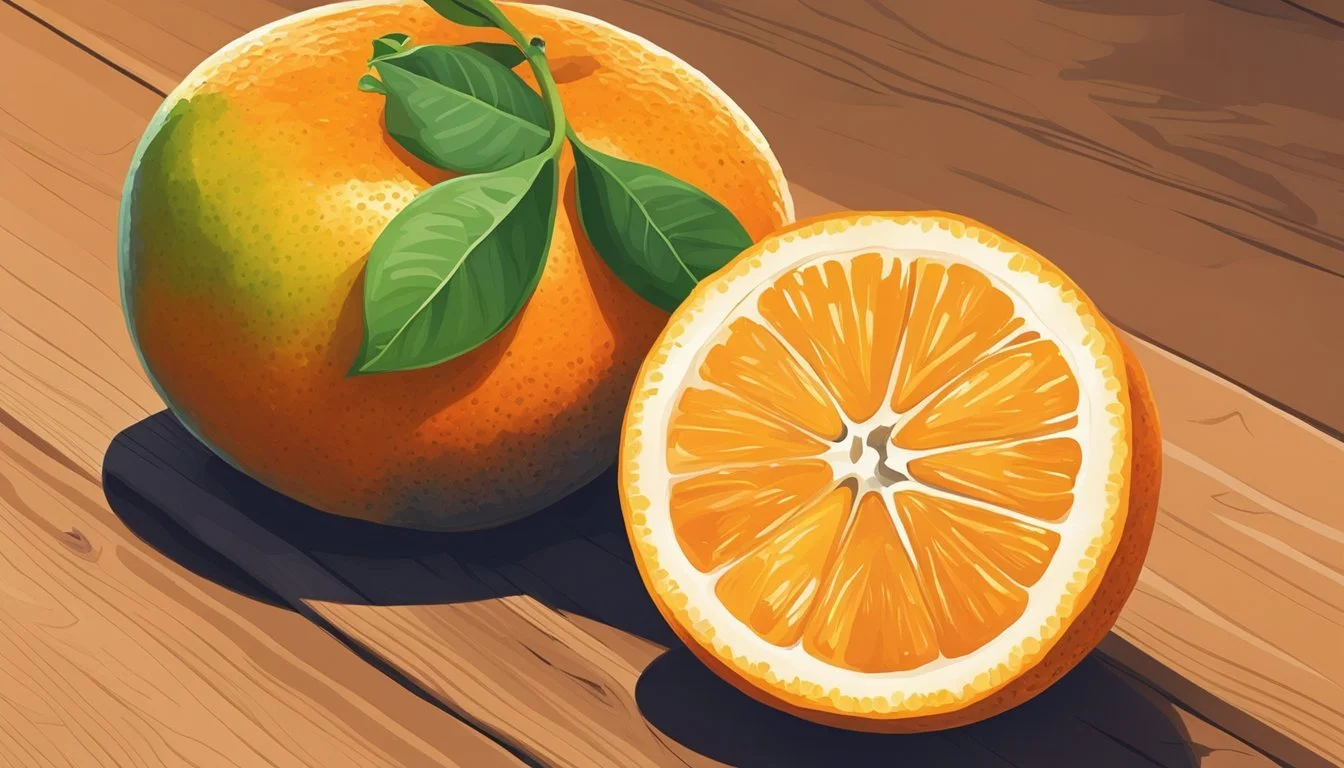How to Tell If an Orange Is Ripe
Selecting the Best for Peak Flavor
Selecting the perfect orange can be likened to finding a small treasure; the reward is a burst of sweetness and a spray of citrus with every slice. Knowing when an orange is ripe and ready to eat is a simple yet crucial skill for anyone looking to enjoy this juicy fruit at its best. While the vibrant orange color of the peel is often associated with ripeness, it can be misleading; oranges can be ripe even when parts of the peel are still green.
Oranges emit a sweet and fragrant aroma when they are ripe, and their skin becomes slightly softer to the touch. However, the timing and condition of ripeness can be influenced by external factors such as climate, the variety of the orange, and the way it has been stored. It's essential to consider these factors, along with the recommendations from experts about the peak season of different orange varieties. Tasting an orange is the ultimate test of its ripeness, revealing the perfect balance of sweetness and acidity.
Key Takeaways
Color is not the only indicator of ripeness; aroma and softness are also important.
The best-tasting oranges are often those chosen during their peak season.
Ripe oranges contribute robust flavor to dishes and offer nutritional benefits.
Identifying Ripe Oranges
Selecting a ripe orange ensures that one experiences the best flavor and juiciness. Proper assessment involves examining several physical attributes.
Color and Appearance
Ripe oranges typically display a bright orange color, but color alone may not be a reliable indicator due to the natural occurrence of "regreening." Regreening is common in warmer climates, where some ripe oranges can have green or partially green peels. A more accurate sign might be a consistent coloration combined with other factors. Look for an absence of blemishes and a vibrant hue, but also pay attention to feel and heft.
Weight and Size
A ripe orange often feels heavy for its size, indicating juiciness. When selecting an orange, compare its weight to another of a similar size; the heavier one is likely the riper choice. The size of the orange does not necessarily correlate with ripeness, but a fully ripe orange will have reached its expected size for its variety.
Texture and Firmness
A ripe orange should be firm, yet yield slightly to pressure, indicating its readiness to eat. The surface should be smooth, but not too hard. Overly soft or spongy areas may suggest over-ripeness or internal spoilage. Some ripe oranges may also have a small yellow spot where they rested on the ground, which is not a sign of imperfection.
The Role of Aroma and Taste
The sensory experience of aroma and taste are pivotal in determining the ripeness of an orange. They provide reliable cues that can guide consumers in choosing fruit with the optimal balance of flavor.
Smell as an Indicator
One can often gauge the ripeness of an orange by its smell. A ripe orange should emit a strong, citrus aroma that is both sweet and distinctive. The presence of a fragrance is indicative of a fruit that has developed its natural sugars and is likely at the peak of its sweetness. An underripe orange, by contrast, may have a faint or almost nonexistent smell, indicating that it may not have reached its full flavor potential.
Taste Testing
When it's feasible to sample, taste is a definitive tool for assessing ripeness. A ripe orange should taste sweet with a tangy undertone, reflecting a harmonious balance between sugar and acid. The intensity of sweetness typically increases as the fruit matures, so a bland or overly sour taste may signify that the orange has not yet ripened enough for consumption. One should be mindful to avoid overripe oranges, which can taste fermented or overly soft.
External Factors Affecting Ripeness
The ripeness of an orange is significantly influenced by the temperature and environment in which it matures, as well as the presence of ethylene gas from neighboring fruits which can accelerate the ripening process.
Temperature and Environment
Oranges typically reach peak ripeness in conditions that balance warmth and coolness. The ideal temperature range for ripening oranges is between 68°F to 86°F (20°C to 30°C). Higher temperatures might hasten ripening, while climates cooler than this range can slow it down. Humidity also plays a role; too much moisture can promote fungal growth, which affects the quality and ripeness. Additionally, while sunlight is essential for the initial development of oranges, direct sunlight after harvesting can lead to over-ripening or dehydration.
Exposure to Ethylene-Producing Fruits
Ethylene gas is a natural plant hormone that triggers the ripening process. When oranges are stored near ethylene-producing fruits like apples, bananas, and tomatoes, they ripen faster. This can be advantageous if one aims to ripen oranges quickly but should be done with caution to avoid premature or uneven ripening.
Ethylene producers:
Apples
Bananas
Tomatoes
Keep separated: Ensure that oranges are stored away from these fruits unless rapid ripening is desired.
Storing and Handling Oranges
Proper storage and handling are crucial for maintaining the freshness and extending the shelf life of oranges. Knowing whether to refrigerate or keep oranges at room temperature, and how to prevent mold and spoilage, can ensure one gets the best taste and value from their citrus fruits.
Refrigeration vs. Countertop
Refrigerator: Oranges stored in a refrigerator maintain freshness for a longer period due to the cool environment that slows down decay. Typically, they can be kept fresh for three to six weeks when refrigerated between 41 and 42 degrees Fahrenheit. When utilizing refrigeration, it is best to store oranges in the fruit drawer away from strong-smelling foods to prevent aroma transfer.
Temperature: 41-42°F (5-6°C)
Expected shelf-life: 3-6 weeks
Countertop: For those planning to consume oranges within a few days, storing them at room temperature on a countertop or in a fruit bowl is appropriate. In a typical home environment, oranges will last about a week before they start to deteriorate. They should be kept out of direct sunlight and away from heat sources to avoid premature spoilage.
Temperature: Room temperature (around 68-72°F or 20-22°C)
Expected shelf-life: About a week
Preventing Mold and Spoilage
Air Circulation: To prevent mold growth and spoilage, oranges should be stored in a well-ventilated space. If buying oranges in plastic bags, one should remove the fruits and store them either loosely in a fruit bowl or in a mesh bag to allow air circulation, which minimizes moisture accumulation and inhibits mold development.
Freezer: For longer storage, oranges can be frozen. One should cut the oranges into wedges or slices, arrange them separately on a baking sheet to freeze, then transfer the frozen pieces to a freezer bag, removing as much air as possible. They can be stored like this in the freezer for up to a year.
Preparation: Slice and arrange separately on a baking sheet
Storage method: Airtight freezer bag with air removed
Expected shelf-life: Up to 12 months
Choosing the Right Variety
Selecting the perfect orange starts with knowing the various types of oranges and their peak seasons. Understanding these factors ensures that the consumer chooses an orange that meets their flavor expectations and is in the best condition for consumption.
Common Orange Varieties
Oranges come in numerous varieties, each offering a unique taste and texture. Here’s a look at some of the more common varieties:
Navel Oranges: Easily recognizable by the small, navel-like formation on their peel, navels are seedless, easy to peel, and are known for their sweetness.
Valencia Oranges: Often associated with orange juice, Valencias have seeds and are prized for their high juice content.
Blood Oranges: With their distinctive burgundy-colored flesh, blood oranges are slightly smaller in size and offer a unique, raspberry-like flavor.
Mandarins: Including varieties like satsumas and clementines, mandarins are smaller, sweeter, and easier to peel than other oranges.
It's important to note that some oranges, despite still retaining a greenish hue, can be ripe and sweet—color alone shouldn’t be the sole indicator of ripeness.
Seasonal Availability
Orange varieties bear fruit at different times of the year, affecting their sweetness and availability. Here’s a quick guide to the seasons of common orange varieties:
Navel: Typical Season - Midwinter to early spring
Valencia: Typical Season - Late spring to midsummer
Blood: Typical Season - Early winter to early spring
Mandarins: Typical Season - Varies by subtype; generally winter
Understanding the seasonality of oranges is crucial, as it not only impacts your chances of purchasing a ripe citrus fruit but also ensures that you are enjoying the variety when it's at its peak flavor profile.
Ripening Oranges at Home
Ripening oranges at home can be easily managed with appropriate techniques and a bit of patience. The natural ripening process can be accelerated by leveraging the ethylene gas produced by certain fruits.
Use of Other Fruits
Ripening oranges in the company of other fruits is an efficient technique due to the ethylene gas they emit. Ethylene is a natural plant hormone that encourages ripening.
Bananas are a potent source of ethylene and can effectively speed up the ripening process of oranges when placed near them.
Apples and pears also emit ethylene and can be used similarly to bananas. Place unripe oranges in a bowl together with any of these ripe fruits to hasten ripening.
Monitoring the Ripening Process
Tracking ripeness is crucial to avoid over-ripening, which can lead to a loss of flavor and potentially spoilage.
Check the firmness of oranges daily; a ripe orange should yield slightly to pressure but not feel too soft.
Observe color changes, but remember that a fully orange color is not the sole indicator of ripeness due to potential "regreening."
Smell is a good indicator as well—ripe oranges typically emit a more robust, sweet aroma.
Avoiding Overripe Oranges
Selecting the perfect orange involves not only identifying ripeness but also avoiding fruit that has passed its prime. Overripe oranges may not provide the optimal taste and texture that one expects from fresh produce.
Signs of Overripeness
Soft Spots: Gently squeeze the orange in your hand; if it yields easily and has spongy areas, it indicates overripeness.
Wrinkling: A healthy ripe orange has a firm, smooth skin. An overripe one exhibits wrinkling or shriveling, signaling that it may be past its best eating quality.
Discoloration and Mold: Check for any unusual dark spots or the presence of mold, which can appear as fuzzy spots on the peel. This is a clear sign the orange has spoiled and should be discarded.
How to Prevent Overripening
Proper Storage: Keep oranges in a cool, airy space, and avoid leaving them out at room temperature for extended periods after they have ripened.
Regular Inspection: Periodically inspect oranges for any of the aforementioned signs of overripeness, especially if you purchase in bulk.
Refrigeration: If you can't consume ripe oranges promptly, refrigeration can help slow down the overripening process.
By observing these indicators and following proper storage techniques, one can ensure that they enjoy their oranges at the peak of freshness.
Health Benefits and Nutrition
Oranges are celebrated for their high vitamin C content and quality as a nutrient-rich, sweet fruit. They provide a burst of freshness and juiciness that contributes to a healthy diet.
Nutritional Content
A medium-sized orange contains:
Calories: Approximately 60
Vitamin C: Around 70 milligrams, which is over 100% of the recommended daily value (DV)
Folate: Roughly 9% of the DV
Calcium: About 5% of the DV
Potassium: Around 5% of the DV
Oranges are inherently low in fat and sodium, and they are a good source of fiber, with about 3 grams per fruit. They also offer a moderate amount of natural sugars that provide energy, making them an excellent choice for a refreshing and nutritive snack.
Antioxidant Properties
Oranges are rich in antioxidants, which are compounds that can protect the body's cells from damage. Vitamin C, a potent antioxidant found abundantly in oranges, is crucial for the maintenance of skin health and immune function. Antioxidant properties of oranges can be attributed to their content of various bioactive compounds, which further includes flavonoids like hesperidin. These antioxidants contribute to their ability to combat oxidative stress and may play a role in reducing the risk of chronic diseases.
Using Ripe Oranges in Cuisine
Selecting ripe oranges is paramount to enhancing flavor profiles in culinary applications. They provide the perfect balance of sweetness and acidity, elevating dishes and drinks alike.
Preparation for Culinary Use
Before using ripe oranges in any recipe, they should be washed and patted dry. Oranges at peak ripeness offer the best juiciness for liquid applications and the most flavorful zest for aromatic enhancement. For zest, use a fine grater to capture the colored part of the peel, avoiding the bitter white pith. When juicing, room temperature oranges yield more liquid, so one should take them out of the refrigerator ahead of time. A taste test can confirm sweetness and determine if additional sweet fruits or sugar are needed to balance the dish.
Wash the oranges: Remove any dirt or debris.
Dry thoroughly: Prevents slipping while cutting.
Grate for zest: Only the outer, colored peel.
Juice oranges: Roll before cutting to maximize juiciness.
Orange-Based Recipes and Drinks
Ripe oranges can be the star of both sweet and savory dishes as well as a variety of drinks. For culinary dishes, segments can be added to salads, used as a garnish, or as a sweet counterpoint in meat-centric recipes. Desserts can include orange segments, zest, or juice to create flavorful cakes, pastries, and confections.
Drinks range from simple orange-infused water to sophisticated cocktails. A classic example is the 'Orange Crush,' where fresh orange juice is mixed with vodka, triple sec, and a splash of soda. Using ripe oranges in cocktails amplifies the sweetness and juiciness, which can reduce the need for added sugars or artificial sweeteners.
Savory dishes: Add orange segments for a sweet twist.
Desserts: Use zest and juice for natural orange flavor.
Cocktails: Fresh juice enhances sweetness and reduces added sugar.






